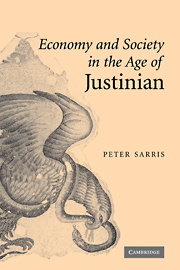Book contents
- Frontmatter
- Contents
- List of figures
- Preface
- Introduction
- 1 Egypt and the political economy of empire
- 2 The Apion archive: economic structure and estate accounts
- 3 Labour and administration: the evidence of the contractual papyri
- 4 Letters and petitions: social relations in the sixth-century Oxyrhynchite
- 5 The Apiones and their analogues
- 6 On the margins of magnate power: Dioscorus and Aphrodito
- 7 Landscapes of power: the great estate beyond Egypt
- 8 The historiography of the great estate
- 9 The great estate and the imperial authorities
- 10 The rise of the great estate
- 11 Economy and society in the age of Justinian
- Conclusion
- Bibliography
- Index
5 - The Apiones and their analogues
Published online by Cambridge University Press: 24 July 2009
- Frontmatter
- Contents
- List of figures
- Preface
- Introduction
- 1 Egypt and the political economy of empire
- 2 The Apion archive: economic structure and estate accounts
- 3 Labour and administration: the evidence of the contractual papyri
- 4 Letters and petitions: social relations in the sixth-century Oxyrhynchite
- 5 The Apiones and their analogues
- 6 On the margins of magnate power: Dioscorus and Aphrodito
- 7 Landscapes of power: the great estate beyond Egypt
- 8 The historiography of the great estate
- 9 The great estate and the imperial authorities
- 10 The rise of the great estate
- 11 Economy and society in the age of Justinian
- Conclusion
- Bibliography
- Index
Summary
THE APION ESTATES: LOCAL PREDOMINANCE AND SCALE
As well as revealing the organisational and administrative structure of the Apion household, the documentary papyri provide important evidence for the extent of the family's estates in the Oxyrhynchite in the sixth and seventh centuries. In the fourth century the geographical area traditionally administered from Oxyrhynchus – the so-called ‘Oxyrhynchite nome’, extending some 40 km to the north of the city, 15 km to the east, and 25 km to its south – had been subdivided into ten administrative units termed pagi, numbered on a south to north axis. The documentary papyri record that, by the end of the sixth century, the Apion family was in possession of epoikia, autourgiai, and village properties the length and breadth of this region. The family owned property as far south as the first of the fourth-century pagi, around the settlement of Ision Panga, as well as in the vicinity of the village of Takona near the line of demarcation between the northernmost ninth and tenth pagi. Likewise, it owned property from the autourgia ‘Outside the Gate’, in the immediate outskirts of Oxyrhynchus, to the village of Pakerke and the nome's eastern boundary, coterminous with the banks of the River Nile.
These Oxyrhynchite estates expanded and developed from the fifth century onwards. This process of expansion is discernible through the sources by virtue of the Apion household's tendency to name properties after the individuals from whom they had been acquired. P.Oxy. XXXIV 2718, for example, dating from 458, makes mention of a curialis of Oxyrhynchus by the name of Leucadius.
- Type
- Chapter
- Information
- Economy and Society in the Age of Justinian , pp. 81 - 95Publisher: Cambridge University PressPrint publication year: 2006



